Case Study in Acute Care Facility 2022
VerifiedAdded on 2022/08/12
|13
|2647
|13
AI Summary
Contribute Materials
Your contribution can guide someone’s learning journey. Share your
documents today.

Running head:CASE STUDY IN ACUTE CARE FACILITY
Case Study in Acute Care Facility
Name of the Student
Name of the University
Author Note
Case Study in Acute Care Facility
Name of the Student
Name of the University
Author Note
Secure Best Marks with AI Grader
Need help grading? Try our AI Grader for instant feedback on your assignments.
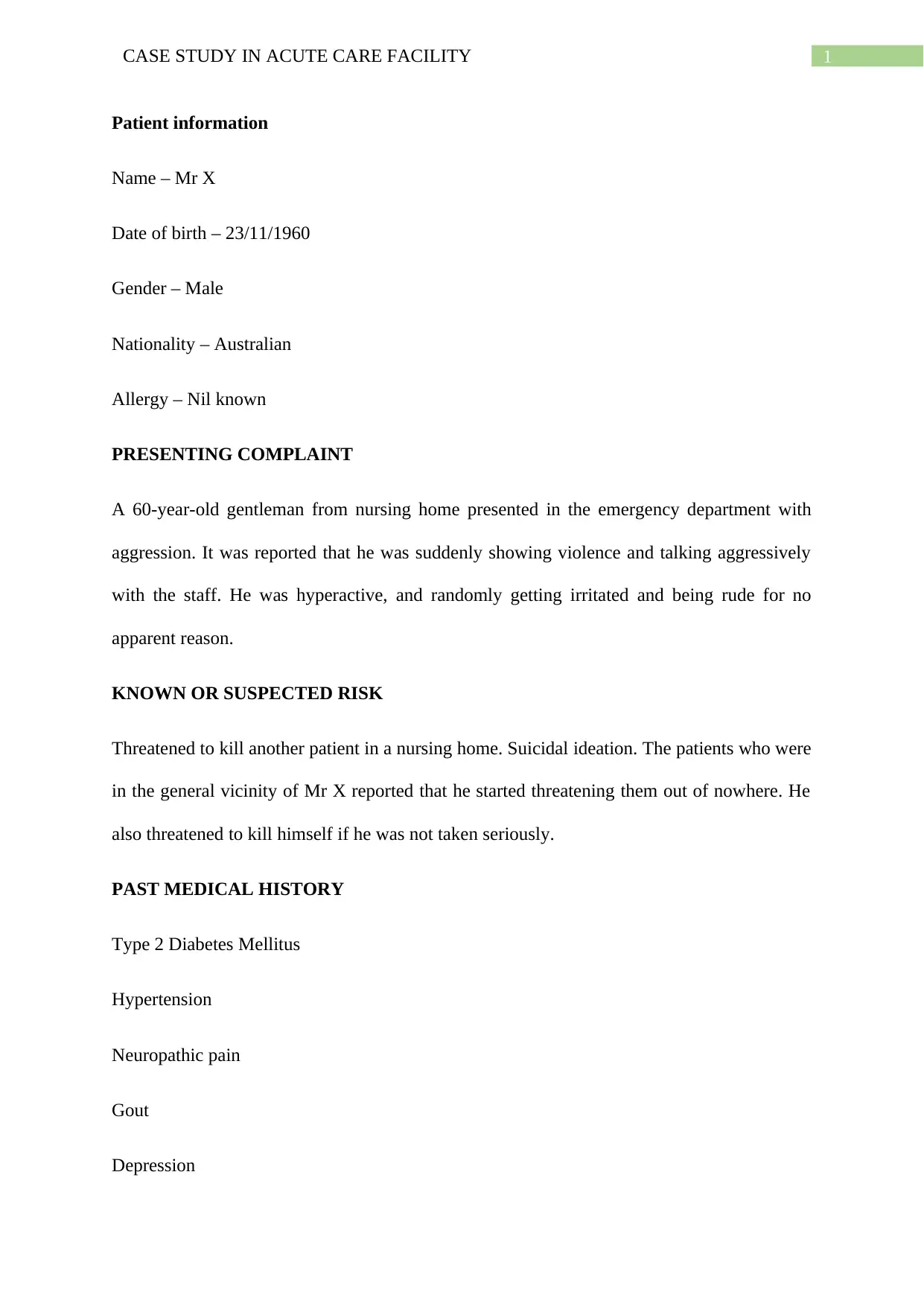
1CASE STUDY IN ACUTE CARE FACILITY
Patient information
Name – Mr X
Date of birth – 23/11/1960
Gender – Male
Nationality – Australian
Allergy – Nil known
PRESENTING COMPLAINT
A 60-year-old gentleman from nursing home presented in the emergency department with
aggression. It was reported that he was suddenly showing violence and talking aggressively
with the staff. He was hyperactive, and randomly getting irritated and being rude for no
apparent reason.
KNOWN OR SUSPECTED RISK
Threatened to kill another patient in a nursing home. Suicidal ideation. The patients who were
in the general vicinity of Mr X reported that he started threatening them out of nowhere. He
also threatened to kill himself if he was not taken seriously.
PAST MEDICAL HISTORY
Type 2 Diabetes Mellitus
Hypertension
Neuropathic pain
Gout
Depression
Patient information
Name – Mr X
Date of birth – 23/11/1960
Gender – Male
Nationality – Australian
Allergy – Nil known
PRESENTING COMPLAINT
A 60-year-old gentleman from nursing home presented in the emergency department with
aggression. It was reported that he was suddenly showing violence and talking aggressively
with the staff. He was hyperactive, and randomly getting irritated and being rude for no
apparent reason.
KNOWN OR SUSPECTED RISK
Threatened to kill another patient in a nursing home. Suicidal ideation. The patients who were
in the general vicinity of Mr X reported that he started threatening them out of nowhere. He
also threatened to kill himself if he was not taken seriously.
PAST MEDICAL HISTORY
Type 2 Diabetes Mellitus
Hypertension
Neuropathic pain
Gout
Depression
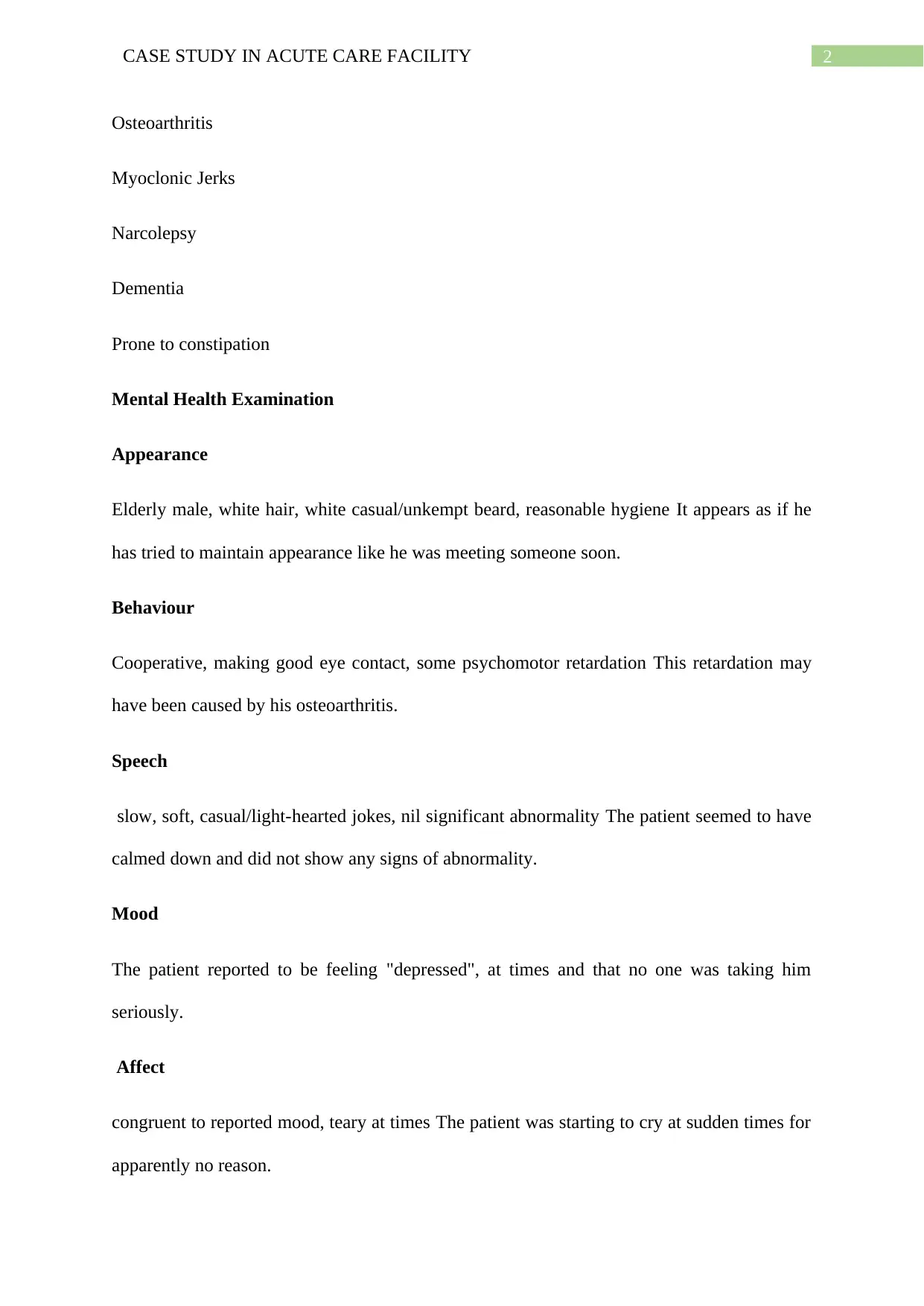
2CASE STUDY IN ACUTE CARE FACILITY
Osteoarthritis
Myoclonic Jerks
Narcolepsy
Dementia
Prone to constipation
Mental Health Examination
Appearance
Elderly male, white hair, white casual/unkempt beard, reasonable hygiene It appears as if he
has tried to maintain appearance like he was meeting someone soon.
Behaviour
Cooperative, making good eye contact, some psychomotor retardation This retardation may
have been caused by his osteoarthritis.
Speech
slow, soft, casual/light-hearted jokes, nil significant abnormality The patient seemed to have
calmed down and did not show any signs of abnormality.
Mood
The patient reported to be feeling "depressed", at times and that no one was taking him
seriously.
Affect
congruent to reported mood, teary at times The patient was starting to cry at sudden times for
apparently no reason.
Osteoarthritis
Myoclonic Jerks
Narcolepsy
Dementia
Prone to constipation
Mental Health Examination
Appearance
Elderly male, white hair, white casual/unkempt beard, reasonable hygiene It appears as if he
has tried to maintain appearance like he was meeting someone soon.
Behaviour
Cooperative, making good eye contact, some psychomotor retardation This retardation may
have been caused by his osteoarthritis.
Speech
slow, soft, casual/light-hearted jokes, nil significant abnormality The patient seemed to have
calmed down and did not show any signs of abnormality.
Mood
The patient reported to be feeling "depressed", at times and that no one was taking him
seriously.
Affect
congruent to reported mood, teary at times The patient was starting to cry at sudden times for
apparently no reason.
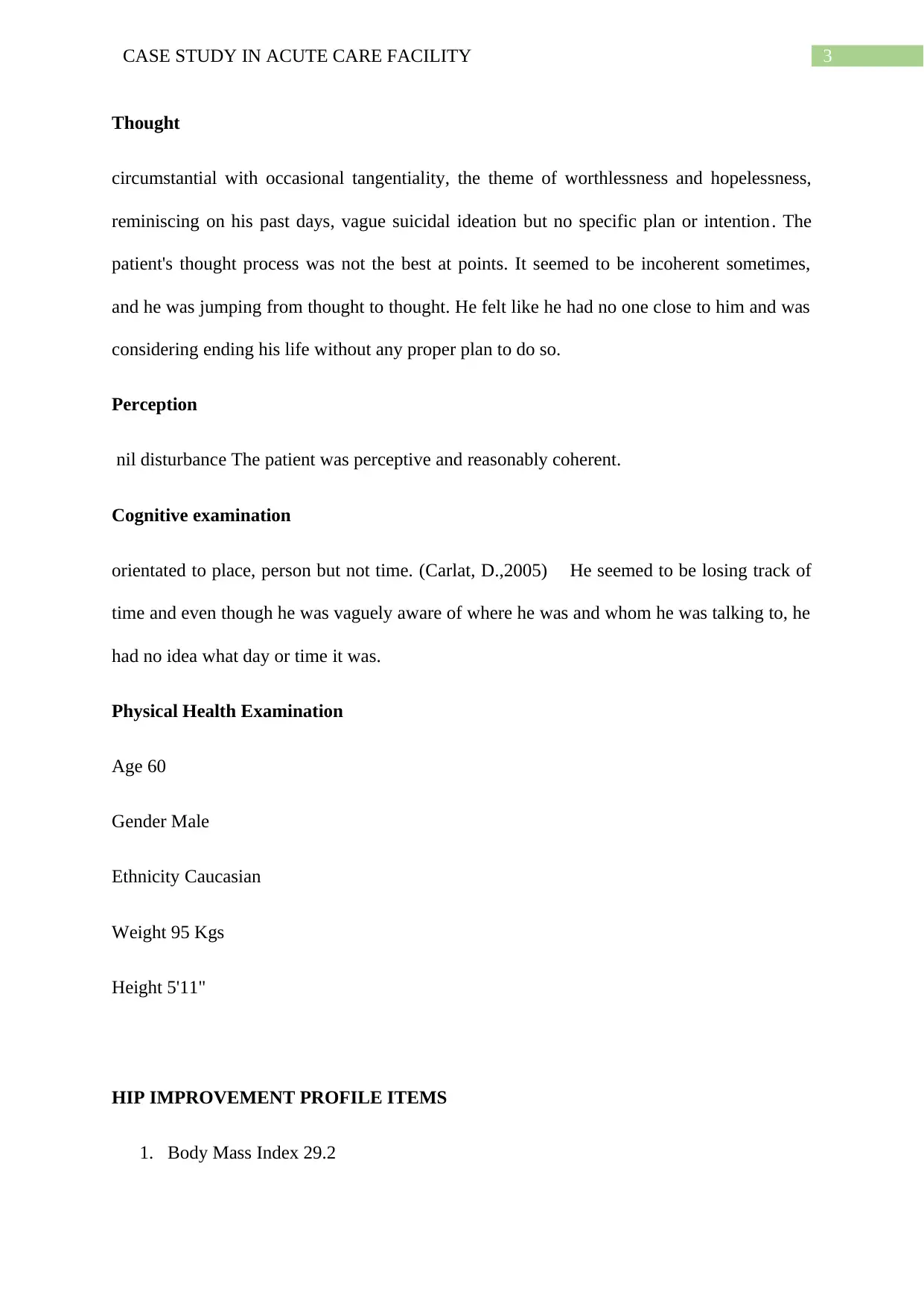
3CASE STUDY IN ACUTE CARE FACILITY
Thought
circumstantial with occasional tangentiality, the theme of worthlessness and hopelessness,
reminiscing on his past days, vague suicidal ideation but no specific plan or intention. The
patient's thought process was not the best at points. It seemed to be incoherent sometimes,
and he was jumping from thought to thought. He felt like he had no one close to him and was
considering ending his life without any proper plan to do so.
Perception
nil disturbance The patient was perceptive and reasonably coherent.
Cognitive examination
orientated to place, person but not time. (Carlat, D.,2005) He seemed to be losing track of
time and even though he was vaguely aware of where he was and whom he was talking to, he
had no idea what day or time it was.
Physical Health Examination
Age 60
Gender Male
Ethnicity Caucasian
Weight 95 Kgs
Height 5'11"
HIP IMPROVEMENT PROFILE ITEMS
1. Body Mass Index 29.2
Thought
circumstantial with occasional tangentiality, the theme of worthlessness and hopelessness,
reminiscing on his past days, vague suicidal ideation but no specific plan or intention. The
patient's thought process was not the best at points. It seemed to be incoherent sometimes,
and he was jumping from thought to thought. He felt like he had no one close to him and was
considering ending his life without any proper plan to do so.
Perception
nil disturbance The patient was perceptive and reasonably coherent.
Cognitive examination
orientated to place, person but not time. (Carlat, D.,2005) He seemed to be losing track of
time and even though he was vaguely aware of where he was and whom he was talking to, he
had no idea what day or time it was.
Physical Health Examination
Age 60
Gender Male
Ethnicity Caucasian
Weight 95 Kgs
Height 5'11"
HIP IMPROVEMENT PROFILE ITEMS
1. Body Mass Index 29.2
Secure Best Marks with AI Grader
Need help grading? Try our AI Grader for instant feedback on your assignments.
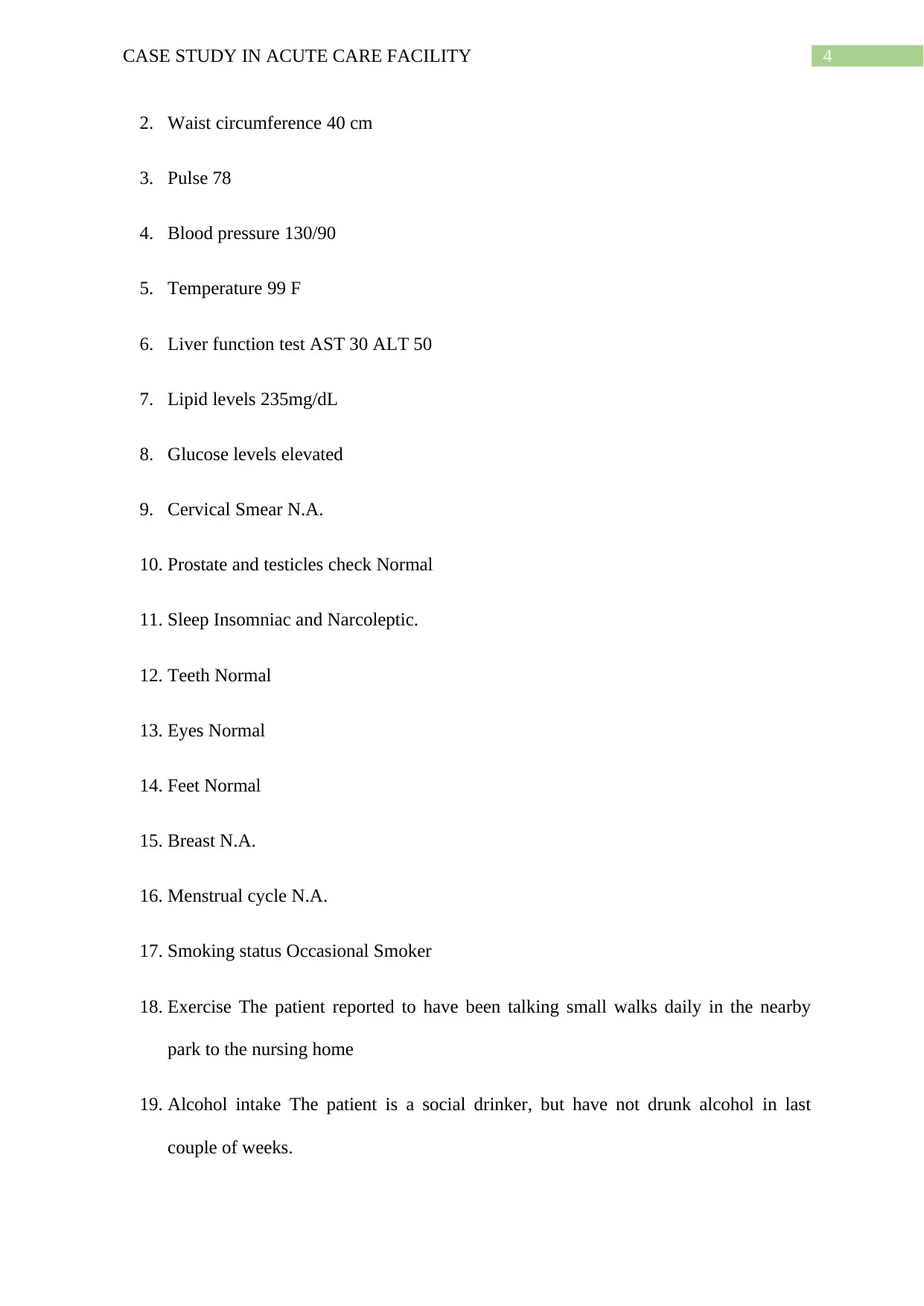
4CASE STUDY IN ACUTE CARE FACILITY
2. Waist circumference 40 cm
3. Pulse 78
4. Blood pressure 130/90
5. Temperature 99 F
6. Liver function test AST 30 ALT 50
7. Lipid levels 235mg/dL
8. Glucose levels elevated
9. Cervical Smear N.A.
10. Prostate and testicles check Normal
11. Sleep Insomniac and Narcoleptic.
12. Teeth Normal
13. Eyes Normal
14. Feet Normal
15. Breast N.A.
16. Menstrual cycle N.A.
17. Smoking status Occasional Smoker
18. Exercise The patient reported to have been talking small walks daily in the nearby
park to the nursing home
19. Alcohol intake The patient is a social drinker, but have not drunk alcohol in last
couple of weeks.
2. Waist circumference 40 cm
3. Pulse 78
4. Blood pressure 130/90
5. Temperature 99 F
6. Liver function test AST 30 ALT 50
7. Lipid levels 235mg/dL
8. Glucose levels elevated
9. Cervical Smear N.A.
10. Prostate and testicles check Normal
11. Sleep Insomniac and Narcoleptic.
12. Teeth Normal
13. Eyes Normal
14. Feet Normal
15. Breast N.A.
16. Menstrual cycle N.A.
17. Smoking status Occasional Smoker
18. Exercise The patient reported to have been talking small walks daily in the nearby
park to the nursing home
19. Alcohol intake The patient is a social drinker, but have not drunk alcohol in last
couple of weeks.
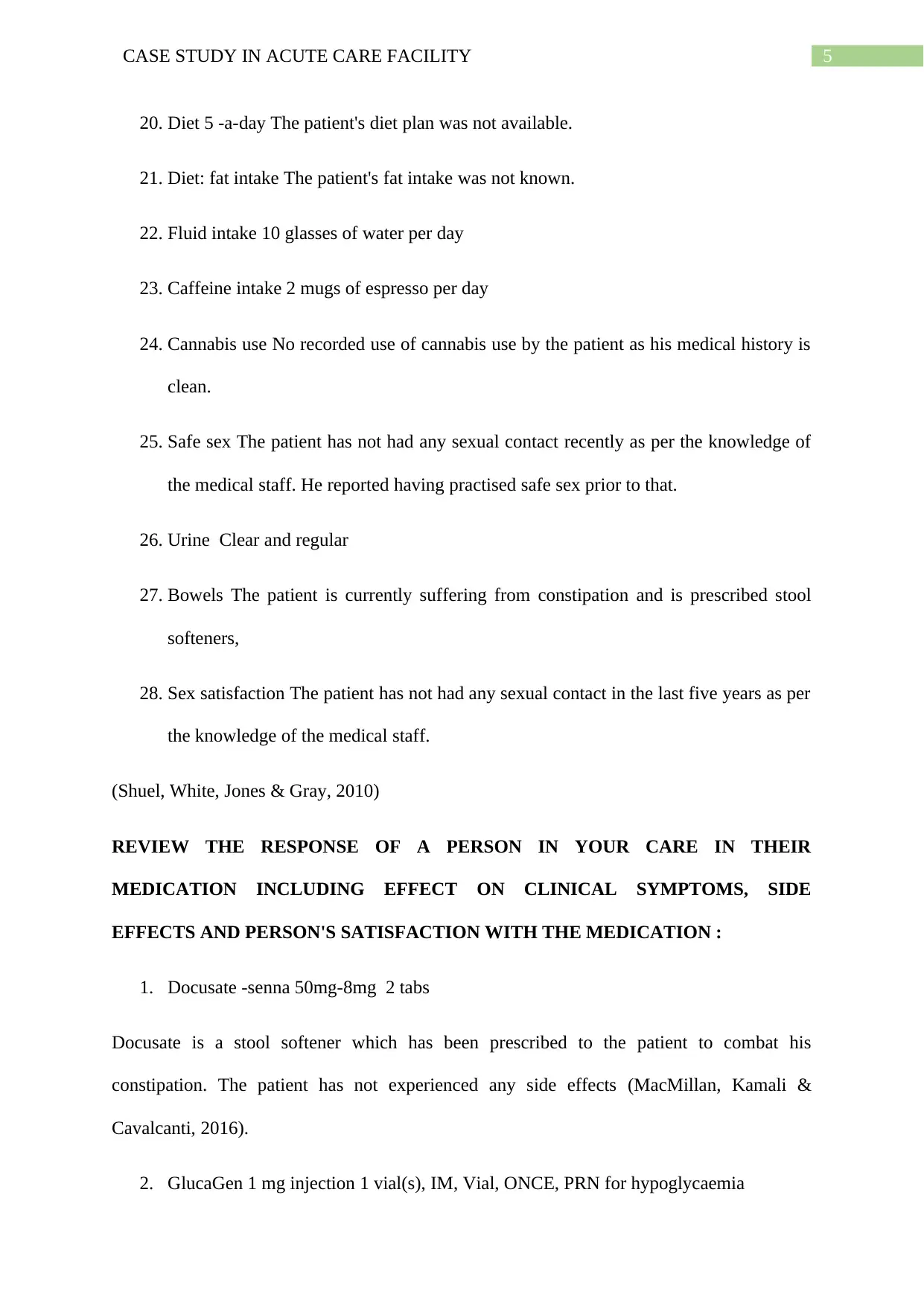
5CASE STUDY IN ACUTE CARE FACILITY
20. Diet 5 -a-day The patient's diet plan was not available.
21. Diet: fat intake The patient's fat intake was not known.
22. Fluid intake 10 glasses of water per day
23. Caffeine intake 2 mugs of espresso per day
24. Cannabis use No recorded use of cannabis use by the patient as his medical history is
clean.
25. Safe sex The patient has not had any sexual contact recently as per the knowledge of
the medical staff. He reported having practised safe sex prior to that.
26. Urine Clear and regular
27. Bowels The patient is currently suffering from constipation and is prescribed stool
softeners,
28. Sex satisfaction The patient has not had any sexual contact in the last five years as per
the knowledge of the medical staff.
(Shuel, White, Jones & Gray, 2010)
REVIEW THE RESPONSE OF A PERSON IN YOUR CARE IN THEIR
MEDICATION INCLUDING EFFECT ON CLINICAL SYMPTOMS, SIDE
EFFECTS AND PERSON'S SATISFACTION WITH THE MEDICATION :
1. Docusate -senna 50mg-8mg 2 tabs
Docusate is a stool softener which has been prescribed to the patient to combat his
constipation. The patient has not experienced any side effects (MacMillan, Kamali &
Cavalcanti, 2016).
2. GlucaGen 1 mg injection 1 vial(s), IM, Vial, ONCE, PRN for hypoglycaemia
20. Diet 5 -a-day The patient's diet plan was not available.
21. Diet: fat intake The patient's fat intake was not known.
22. Fluid intake 10 glasses of water per day
23. Caffeine intake 2 mugs of espresso per day
24. Cannabis use No recorded use of cannabis use by the patient as his medical history is
clean.
25. Safe sex The patient has not had any sexual contact recently as per the knowledge of
the medical staff. He reported having practised safe sex prior to that.
26. Urine Clear and regular
27. Bowels The patient is currently suffering from constipation and is prescribed stool
softeners,
28. Sex satisfaction The patient has not had any sexual contact in the last five years as per
the knowledge of the medical staff.
(Shuel, White, Jones & Gray, 2010)
REVIEW THE RESPONSE OF A PERSON IN YOUR CARE IN THEIR
MEDICATION INCLUDING EFFECT ON CLINICAL SYMPTOMS, SIDE
EFFECTS AND PERSON'S SATISFACTION WITH THE MEDICATION :
1. Docusate -senna 50mg-8mg 2 tabs
Docusate is a stool softener which has been prescribed to the patient to combat his
constipation. The patient has not experienced any side effects (MacMillan, Kamali &
Cavalcanti, 2016).
2. GlucaGen 1 mg injection 1 vial(s), IM, Vial, ONCE, PRN for hypoglycaemia
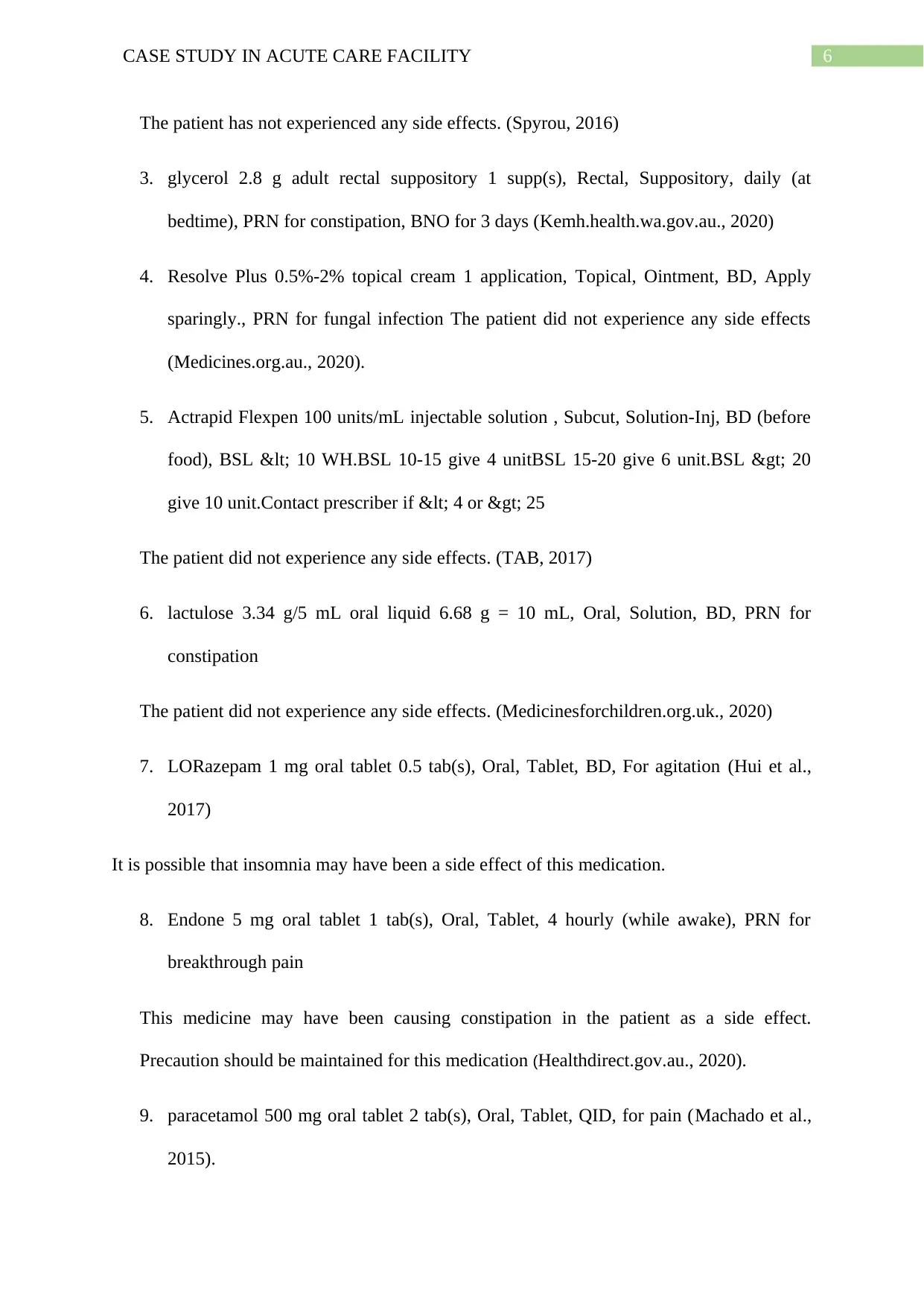
6CASE STUDY IN ACUTE CARE FACILITY
The patient has not experienced any side effects. (Spyrou, 2016)
3. glycerol 2.8 g adult rectal suppository 1 supp(s), Rectal, Suppository, daily (at
bedtime), PRN for constipation, BNO for 3 days (Kemh.health.wa.gov.au., 2020)
4. Resolve Plus 0.5%-2% topical cream 1 application, Topical, Ointment, BD, Apply
sparingly., PRN for fungal infection The patient did not experience any side effects
(Medicines.org.au., 2020).
5. Actrapid Flexpen 100 units/mL injectable solution , Subcut, Solution-Inj, BD (before
food), BSL < 10 WH.BSL 10-15 give 4 unitBSL 15-20 give 6 unit.BSL > 20
give 10 unit.Contact prescriber if < 4 or > 25
The patient did not experience any side effects. (TAB, 2017)
6. lactulose 3.34 g/5 mL oral liquid 6.68 g = 10 mL, Oral, Solution, BD, PRN for
constipation
The patient did not experience any side effects. (Medicinesforchildren.org.uk., 2020)
7. LORazepam 1 mg oral tablet 0.5 tab(s), Oral, Tablet, BD, For agitation (Hui et al.,
2017)
It is possible that insomnia may have been a side effect of this medication.
8. Endone 5 mg oral tablet 1 tab(s), Oral, Tablet, 4 hourly (while awake), PRN for
breakthrough pain
This medicine may have been causing constipation in the patient as a side effect.
Precaution should be maintained for this medication (Healthdirect.gov.au., 2020).
9. paracetamol 500 mg oral tablet 2 tab(s), Oral, Tablet, QID, for pain (Machado et al.,
2015).
The patient has not experienced any side effects. (Spyrou, 2016)
3. glycerol 2.8 g adult rectal suppository 1 supp(s), Rectal, Suppository, daily (at
bedtime), PRN for constipation, BNO for 3 days (Kemh.health.wa.gov.au., 2020)
4. Resolve Plus 0.5%-2% topical cream 1 application, Topical, Ointment, BD, Apply
sparingly., PRN for fungal infection The patient did not experience any side effects
(Medicines.org.au., 2020).
5. Actrapid Flexpen 100 units/mL injectable solution , Subcut, Solution-Inj, BD (before
food), BSL < 10 WH.BSL 10-15 give 4 unitBSL 15-20 give 6 unit.BSL > 20
give 10 unit.Contact prescriber if < 4 or > 25
The patient did not experience any side effects. (TAB, 2017)
6. lactulose 3.34 g/5 mL oral liquid 6.68 g = 10 mL, Oral, Solution, BD, PRN for
constipation
The patient did not experience any side effects. (Medicinesforchildren.org.uk., 2020)
7. LORazepam 1 mg oral tablet 0.5 tab(s), Oral, Tablet, BD, For agitation (Hui et al.,
2017)
It is possible that insomnia may have been a side effect of this medication.
8. Endone 5 mg oral tablet 1 tab(s), Oral, Tablet, 4 hourly (while awake), PRN for
breakthrough pain
This medicine may have been causing constipation in the patient as a side effect.
Precaution should be maintained for this medication (Healthdirect.gov.au., 2020).
9. paracetamol 500 mg oral tablet 2 tab(s), Oral, Tablet, QID, for pain (Machado et al.,
2015).
Paraphrase This Document
Need a fresh take? Get an instant paraphrase of this document with our AI Paraphraser
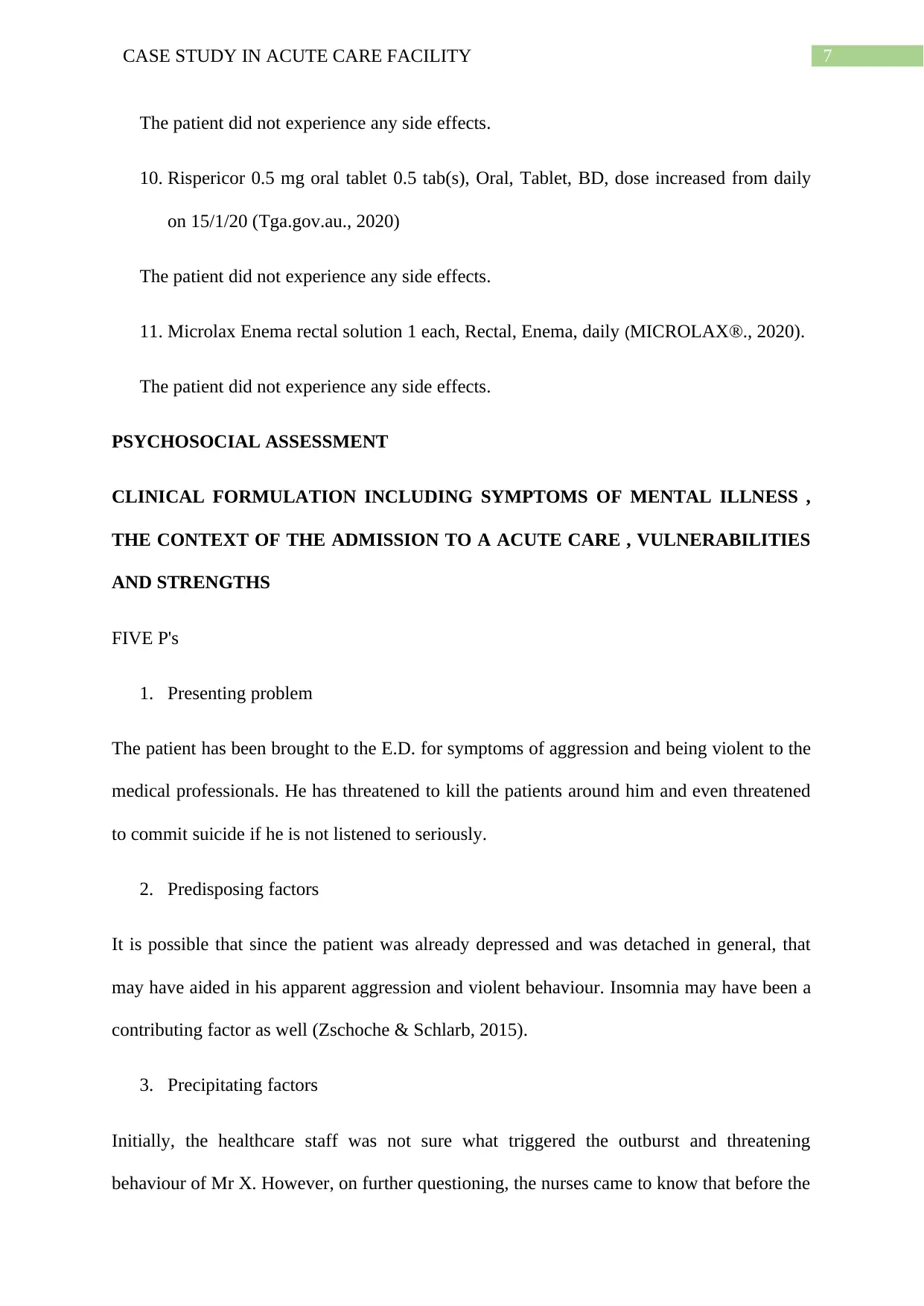
7CASE STUDY IN ACUTE CARE FACILITY
The patient did not experience any side effects.
10. Rispericor 0.5 mg oral tablet 0.5 tab(s), Oral, Tablet, BD, dose increased from daily
on 15/1/20 (Tga.gov.au., 2020)
The patient did not experience any side effects.
11. Microlax Enema rectal solution 1 each, Rectal, Enema, daily (MICROLAX®., 2020).
The patient did not experience any side effects.
PSYCHOSOCIAL ASSESSMENT
CLINICAL FORMULATION INCLUDING SYMPTOMS OF MENTAL ILLNESS ,
THE CONTEXT OF THE ADMISSION TO A ACUTE CARE , VULNERABILITIES
AND STRENGTHS
FIVE P's
1. Presenting problem
The patient has been brought to the E.D. for symptoms of aggression and being violent to the
medical professionals. He has threatened to kill the patients around him and even threatened
to commit suicide if he is not listened to seriously.
2. Predisposing factors
It is possible that since the patient was already depressed and was detached in general, that
may have aided in his apparent aggression and violent behaviour. Insomnia may have been a
contributing factor as well (Zschoche & Schlarb, 2015).
3. Precipitating factors
Initially, the healthcare staff was not sure what triggered the outburst and threatening
behaviour of Mr X. However, on further questioning, the nurses came to know that before the
The patient did not experience any side effects.
10. Rispericor 0.5 mg oral tablet 0.5 tab(s), Oral, Tablet, BD, dose increased from daily
on 15/1/20 (Tga.gov.au., 2020)
The patient did not experience any side effects.
11. Microlax Enema rectal solution 1 each, Rectal, Enema, daily (MICROLAX®., 2020).
The patient did not experience any side effects.
PSYCHOSOCIAL ASSESSMENT
CLINICAL FORMULATION INCLUDING SYMPTOMS OF MENTAL ILLNESS ,
THE CONTEXT OF THE ADMISSION TO A ACUTE CARE , VULNERABILITIES
AND STRENGTHS
FIVE P's
1. Presenting problem
The patient has been brought to the E.D. for symptoms of aggression and being violent to the
medical professionals. He has threatened to kill the patients around him and even threatened
to commit suicide if he is not listened to seriously.
2. Predisposing factors
It is possible that since the patient was already depressed and was detached in general, that
may have aided in his apparent aggression and violent behaviour. Insomnia may have been a
contributing factor as well (Zschoche & Schlarb, 2015).
3. Precipitating factors
Initially, the healthcare staff was not sure what triggered the outburst and threatening
behaviour of Mr X. However, on further questioning, the nurses came to know that before the
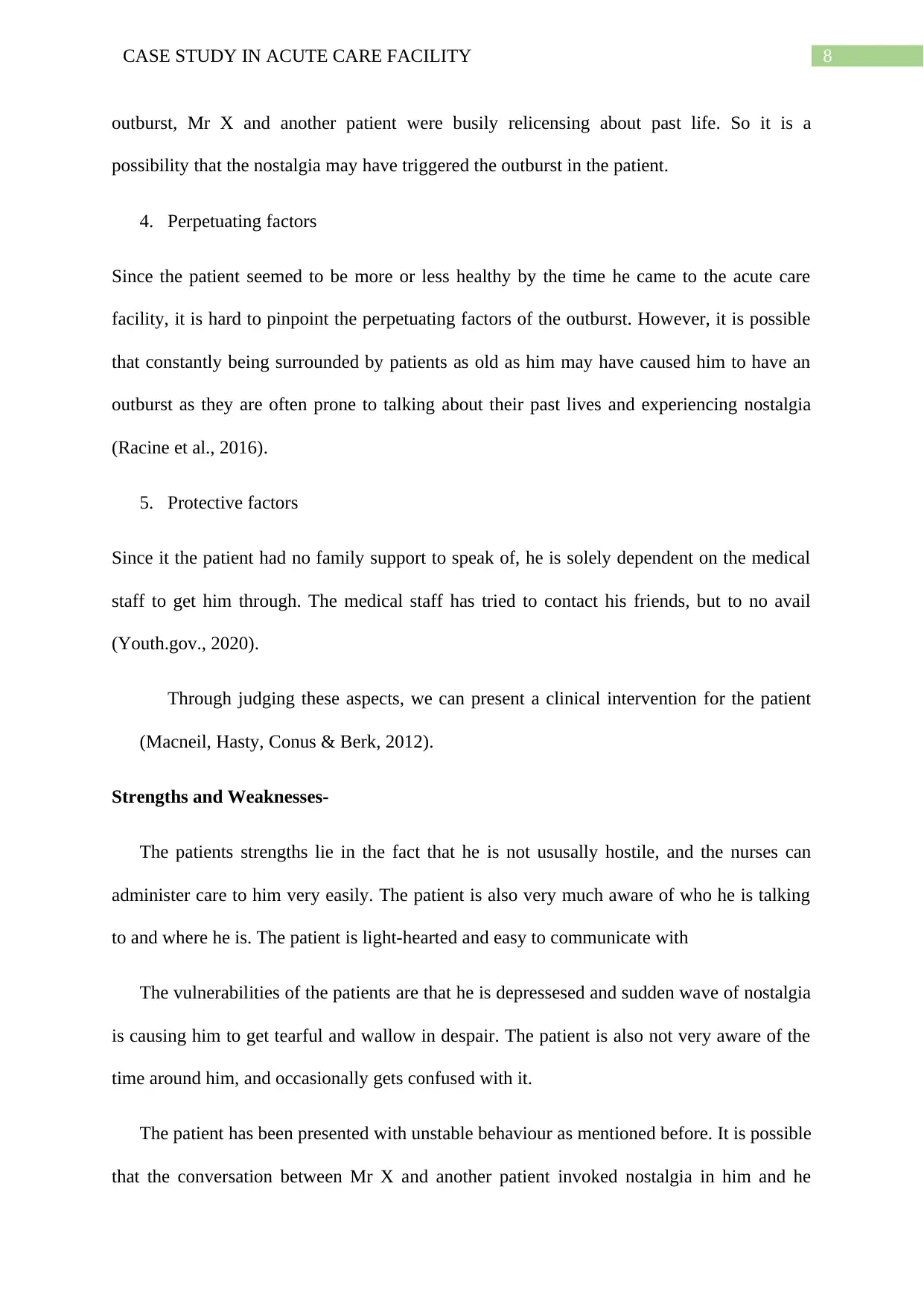
8CASE STUDY IN ACUTE CARE FACILITY
outburst, Mr X and another patient were busily relicensing about past life. So it is a
possibility that the nostalgia may have triggered the outburst in the patient.
4. Perpetuating factors
Since the patient seemed to be more or less healthy by the time he came to the acute care
facility, it is hard to pinpoint the perpetuating factors of the outburst. However, it is possible
that constantly being surrounded by patients as old as him may have caused him to have an
outburst as they are often prone to talking about their past lives and experiencing nostalgia
(Racine et al., 2016).
5. Protective factors
Since it the patient had no family support to speak of, he is solely dependent on the medical
staff to get him through. The medical staff has tried to contact his friends, but to no avail
(Youth.gov., 2020).
Through judging these aspects, we can present a clinical intervention for the patient
(Macneil, Hasty, Conus & Berk, 2012).
Strengths and Weaknesses-
The patients strengths lie in the fact that he is not ususally hostile, and the nurses can
administer care to him very easily. The patient is also very much aware of who he is talking
to and where he is. The patient is light-hearted and easy to communicate with
The vulnerabilities of the patients are that he is depressesed and sudden wave of nostalgia
is causing him to get tearful and wallow in despair. The patient is also not very aware of the
time around him, and occasionally gets confused with it.
The patient has been presented with unstable behaviour as mentioned before. It is possible
that the conversation between Mr X and another patient invoked nostalgia in him and he
outburst, Mr X and another patient were busily relicensing about past life. So it is a
possibility that the nostalgia may have triggered the outburst in the patient.
4. Perpetuating factors
Since the patient seemed to be more or less healthy by the time he came to the acute care
facility, it is hard to pinpoint the perpetuating factors of the outburst. However, it is possible
that constantly being surrounded by patients as old as him may have caused him to have an
outburst as they are often prone to talking about their past lives and experiencing nostalgia
(Racine et al., 2016).
5. Protective factors
Since it the patient had no family support to speak of, he is solely dependent on the medical
staff to get him through. The medical staff has tried to contact his friends, but to no avail
(Youth.gov., 2020).
Through judging these aspects, we can present a clinical intervention for the patient
(Macneil, Hasty, Conus & Berk, 2012).
Strengths and Weaknesses-
The patients strengths lie in the fact that he is not ususally hostile, and the nurses can
administer care to him very easily. The patient is also very much aware of who he is talking
to and where he is. The patient is light-hearted and easy to communicate with
The vulnerabilities of the patients are that he is depressesed and sudden wave of nostalgia
is causing him to get tearful and wallow in despair. The patient is also not very aware of the
time around him, and occasionally gets confused with it.
The patient has been presented with unstable behaviour as mentioned before. It is possible
that the conversation between Mr X and another patient invoked nostalgia in him and he
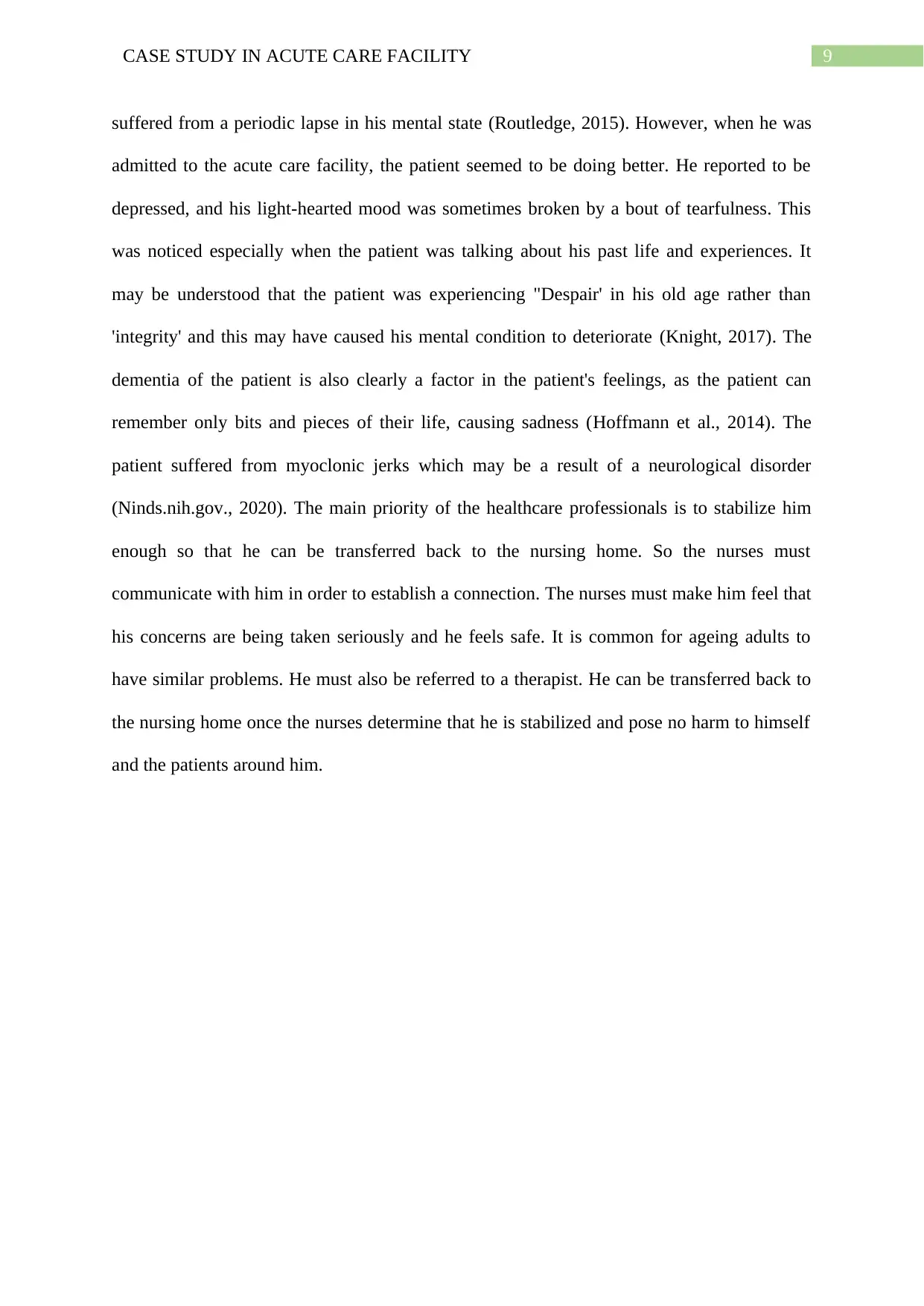
9CASE STUDY IN ACUTE CARE FACILITY
suffered from a periodic lapse in his mental state (Routledge, 2015). However, when he was
admitted to the acute care facility, the patient seemed to be doing better. He reported to be
depressed, and his light-hearted mood was sometimes broken by a bout of tearfulness. This
was noticed especially when the patient was talking about his past life and experiences. It
may be understood that the patient was experiencing "Despair' in his old age rather than
'integrity' and this may have caused his mental condition to deteriorate (Knight, 2017). The
dementia of the patient is also clearly a factor in the patient's feelings, as the patient can
remember only bits and pieces of their life, causing sadness (Hoffmann et al., 2014). The
patient suffered from myoclonic jerks which may be a result of a neurological disorder
(Ninds.nih.gov., 2020). The main priority of the healthcare professionals is to stabilize him
enough so that he can be transferred back to the nursing home. So the nurses must
communicate with him in order to establish a connection. The nurses must make him feel that
his concerns are being taken seriously and he feels safe. It is common for ageing adults to
have similar problems. He must also be referred to a therapist. He can be transferred back to
the nursing home once the nurses determine that he is stabilized and pose no harm to himself
and the patients around him.
suffered from a periodic lapse in his mental state (Routledge, 2015). However, when he was
admitted to the acute care facility, the patient seemed to be doing better. He reported to be
depressed, and his light-hearted mood was sometimes broken by a bout of tearfulness. This
was noticed especially when the patient was talking about his past life and experiences. It
may be understood that the patient was experiencing "Despair' in his old age rather than
'integrity' and this may have caused his mental condition to deteriorate (Knight, 2017). The
dementia of the patient is also clearly a factor in the patient's feelings, as the patient can
remember only bits and pieces of their life, causing sadness (Hoffmann et al., 2014). The
patient suffered from myoclonic jerks which may be a result of a neurological disorder
(Ninds.nih.gov., 2020). The main priority of the healthcare professionals is to stabilize him
enough so that he can be transferred back to the nursing home. So the nurses must
communicate with him in order to establish a connection. The nurses must make him feel that
his concerns are being taken seriously and he feels safe. It is common for ageing adults to
have similar problems. He must also be referred to a therapist. He can be transferred back to
the nursing home once the nurses determine that he is stabilized and pose no harm to himself
and the patients around him.
Secure Best Marks with AI Grader
Need help grading? Try our AI Grader for instant feedback on your assignments.
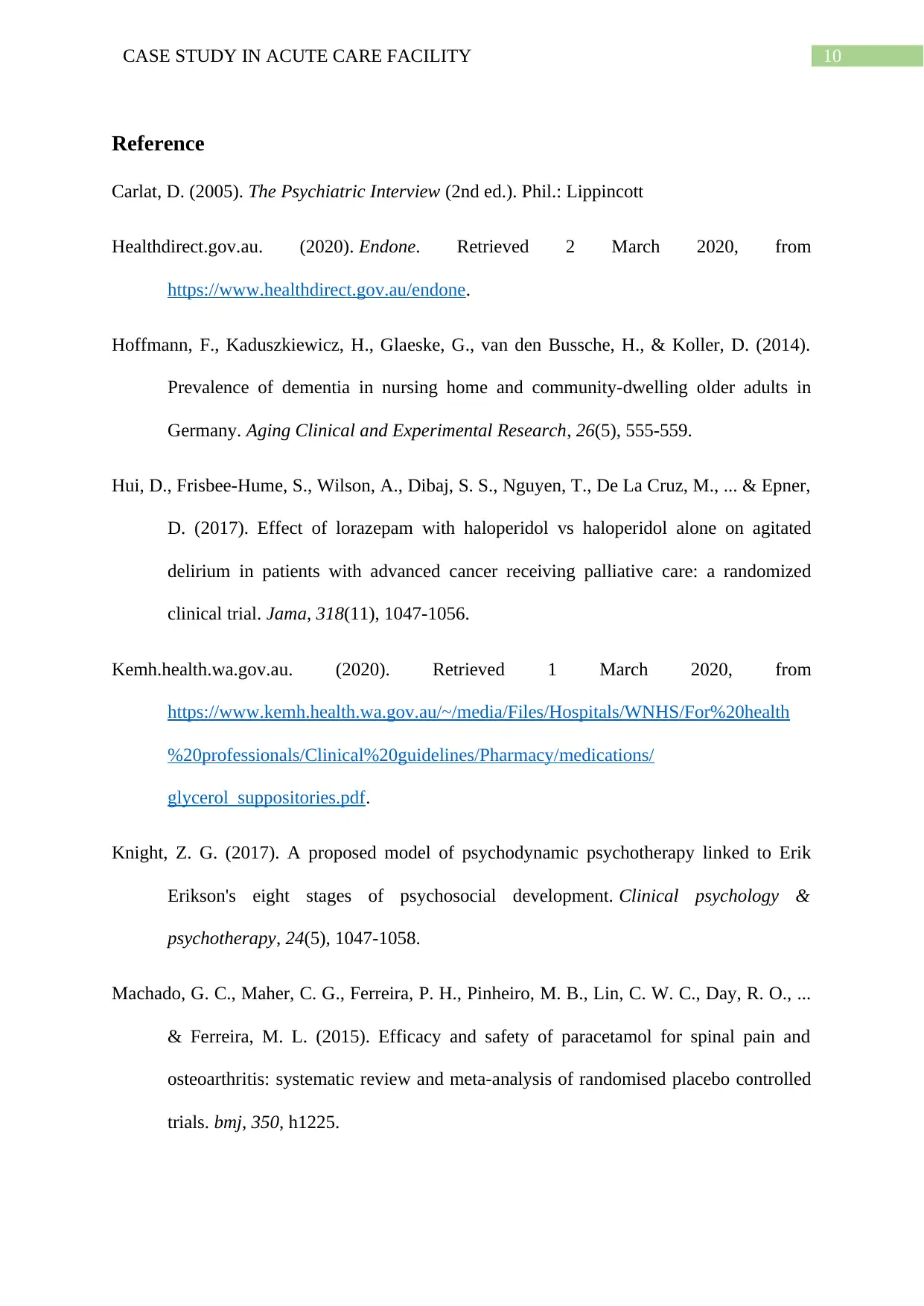
10CASE STUDY IN ACUTE CARE FACILITY
Reference
Carlat, D. (2005). The Psychiatric Interview (2nd ed.). Phil.: Lippincott
Healthdirect.gov.au. (2020). Endone. Retrieved 2 March 2020, from
https://www.healthdirect.gov.au/endone.
Hoffmann, F., Kaduszkiewicz, H., Glaeske, G., van den Bussche, H., & Koller, D. (2014).
Prevalence of dementia in nursing home and community-dwelling older adults in
Germany. Aging Clinical and Experimental Research, 26(5), 555-559.
Hui, D., Frisbee-Hume, S., Wilson, A., Dibaj, S. S., Nguyen, T., De La Cruz, M., ... & Epner,
D. (2017). Effect of lorazepam with haloperidol vs haloperidol alone on agitated
delirium in patients with advanced cancer receiving palliative care: a randomized
clinical trial. Jama, 318(11), 1047-1056.
Kemh.health.wa.gov.au. (2020). Retrieved 1 March 2020, from
https://www.kemh.health.wa.gov.au/~/media/Files/Hospitals/WNHS/For%20health
%20professionals/Clinical%20guidelines/Pharmacy/medications/
glycerol_suppositories.pdf.
Knight, Z. G. (2017). A proposed model of psychodynamic psychotherapy linked to Erik
Erikson's eight stages of psychosocial development. Clinical psychology &
psychotherapy, 24(5), 1047-1058.
Machado, G. C., Maher, C. G., Ferreira, P. H., Pinheiro, M. B., Lin, C. W. C., Day, R. O., ...
& Ferreira, M. L. (2015). Efficacy and safety of paracetamol for spinal pain and
osteoarthritis: systematic review and meta-analysis of randomised placebo controlled
trials. bmj, 350, h1225.
Reference
Carlat, D. (2005). The Psychiatric Interview (2nd ed.). Phil.: Lippincott
Healthdirect.gov.au. (2020). Endone. Retrieved 2 March 2020, from
https://www.healthdirect.gov.au/endone.
Hoffmann, F., Kaduszkiewicz, H., Glaeske, G., van den Bussche, H., & Koller, D. (2014).
Prevalence of dementia in nursing home and community-dwelling older adults in
Germany. Aging Clinical and Experimental Research, 26(5), 555-559.
Hui, D., Frisbee-Hume, S., Wilson, A., Dibaj, S. S., Nguyen, T., De La Cruz, M., ... & Epner,
D. (2017). Effect of lorazepam with haloperidol vs haloperidol alone on agitated
delirium in patients with advanced cancer receiving palliative care: a randomized
clinical trial. Jama, 318(11), 1047-1056.
Kemh.health.wa.gov.au. (2020). Retrieved 1 March 2020, from
https://www.kemh.health.wa.gov.au/~/media/Files/Hospitals/WNHS/For%20health
%20professionals/Clinical%20guidelines/Pharmacy/medications/
glycerol_suppositories.pdf.
Knight, Z. G. (2017). A proposed model of psychodynamic psychotherapy linked to Erik
Erikson's eight stages of psychosocial development. Clinical psychology &
psychotherapy, 24(5), 1047-1058.
Machado, G. C., Maher, C. G., Ferreira, P. H., Pinheiro, M. B., Lin, C. W. C., Day, R. O., ...
& Ferreira, M. L. (2015). Efficacy and safety of paracetamol for spinal pain and
osteoarthritis: systematic review and meta-analysis of randomised placebo controlled
trials. bmj, 350, h1225.
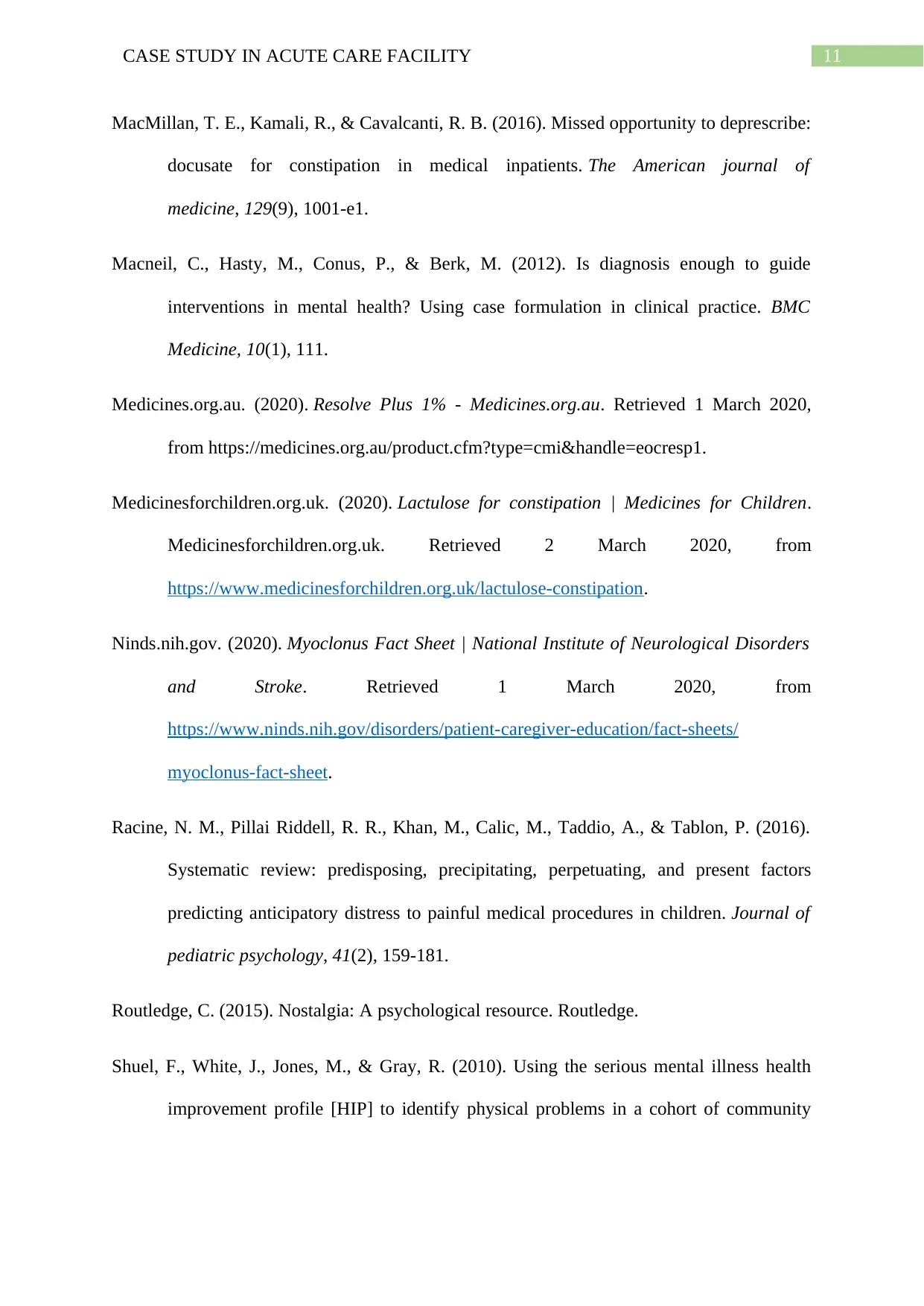
11CASE STUDY IN ACUTE CARE FACILITY
MacMillan, T. E., Kamali, R., & Cavalcanti, R. B. (2016). Missed opportunity to deprescribe:
docusate for constipation in medical inpatients. The American journal of
medicine, 129(9), 1001-e1.
Macneil, C., Hasty, M., Conus, P., & Berk, M. (2012). Is diagnosis enough to guide
interventions in mental health? Using case formulation in clinical practice. BMC
Medicine, 10(1), 111.
Medicines.org.au. (2020). Resolve Plus 1% - Medicines.org.au. Retrieved 1 March 2020,
from https://medicines.org.au/product.cfm?type=cmi&handle=eocresp1.
Medicinesforchildren.org.uk. (2020). Lactulose for constipation | Medicines for Children.
Medicinesforchildren.org.uk. Retrieved 2 March 2020, from
https://www.medicinesforchildren.org.uk/lactulose-constipation.
Ninds.nih.gov. (2020). Myoclonus Fact Sheet | National Institute of Neurological Disorders
and Stroke. Retrieved 1 March 2020, from
https://www.ninds.nih.gov/disorders/patient-caregiver-education/fact-sheets/
myoclonus-fact-sheet.
Racine, N. M., Pillai Riddell, R. R., Khan, M., Calic, M., Taddio, A., & Tablon, P. (2016).
Systematic review: predisposing, precipitating, perpetuating, and present factors
predicting anticipatory distress to painful medical procedures in children. Journal of
pediatric psychology, 41(2), 159-181.
Routledge, C. (2015). Nostalgia: A psychological resource. Routledge.
Shuel, F., White, J., Jones, M., & Gray, R. (2010). Using the serious mental illness health
improvement profile [HIP] to identify physical problems in a cohort of community
MacMillan, T. E., Kamali, R., & Cavalcanti, R. B. (2016). Missed opportunity to deprescribe:
docusate for constipation in medical inpatients. The American journal of
medicine, 129(9), 1001-e1.
Macneil, C., Hasty, M., Conus, P., & Berk, M. (2012). Is diagnosis enough to guide
interventions in mental health? Using case formulation in clinical practice. BMC
Medicine, 10(1), 111.
Medicines.org.au. (2020). Resolve Plus 1% - Medicines.org.au. Retrieved 1 March 2020,
from https://medicines.org.au/product.cfm?type=cmi&handle=eocresp1.
Medicinesforchildren.org.uk. (2020). Lactulose for constipation | Medicines for Children.
Medicinesforchildren.org.uk. Retrieved 2 March 2020, from
https://www.medicinesforchildren.org.uk/lactulose-constipation.
Ninds.nih.gov. (2020). Myoclonus Fact Sheet | National Institute of Neurological Disorders
and Stroke. Retrieved 1 March 2020, from
https://www.ninds.nih.gov/disorders/patient-caregiver-education/fact-sheets/
myoclonus-fact-sheet.
Racine, N. M., Pillai Riddell, R. R., Khan, M., Calic, M., Taddio, A., & Tablon, P. (2016).
Systematic review: predisposing, precipitating, perpetuating, and present factors
predicting anticipatory distress to painful medical procedures in children. Journal of
pediatric psychology, 41(2), 159-181.
Routledge, C. (2015). Nostalgia: A psychological resource. Routledge.
Shuel, F., White, J., Jones, M., & Gray, R. (2010). Using the serious mental illness health
improvement profile [HIP] to identify physical problems in a cohort of community
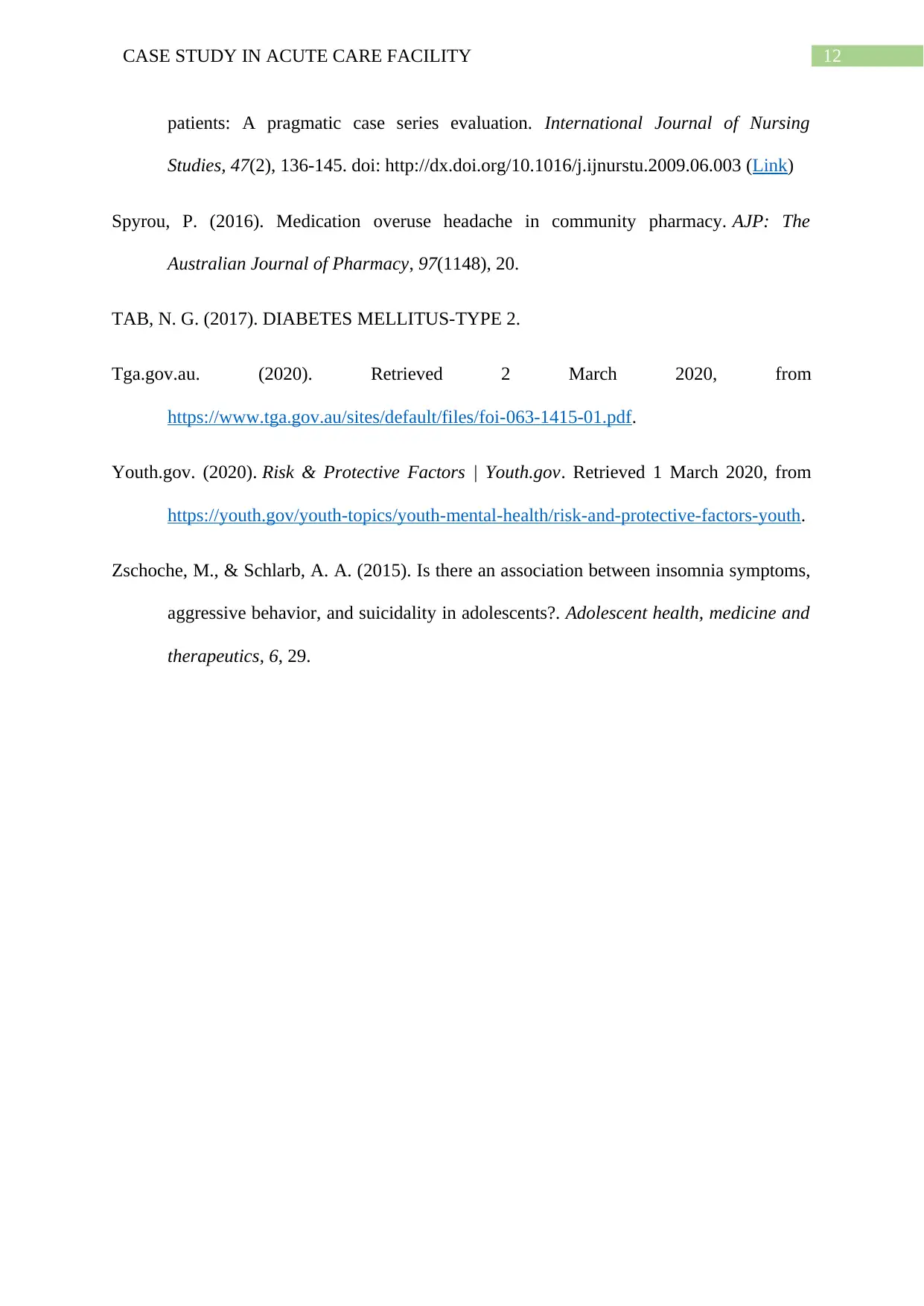
12CASE STUDY IN ACUTE CARE FACILITY
patients: A pragmatic case series evaluation. International Journal of Nursing
Studies, 47(2), 136-145. doi: http://dx.doi.org/10.1016/j.ijnurstu.2009.06.003 (Link)
Spyrou, P. (2016). Medication overuse headache in community pharmacy. AJP: The
Australian Journal of Pharmacy, 97(1148), 20.
TAB, N. G. (2017). DIABETES MELLITUS-TYPE 2.
Tga.gov.au. (2020). Retrieved 2 March 2020, from
https://www.tga.gov.au/sites/default/files/foi-063-1415-01.pdf.
Youth.gov. (2020). Risk & Protective Factors | Youth.gov. Retrieved 1 March 2020, from
https://youth.gov/youth-topics/youth-mental-health/risk-and-protective-factors-youth.
Zschoche, M., & Schlarb, A. A. (2015). Is there an association between insomnia symptoms,
aggressive behavior, and suicidality in adolescents?. Adolescent health, medicine and
therapeutics, 6, 29.
patients: A pragmatic case series evaluation. International Journal of Nursing
Studies, 47(2), 136-145. doi: http://dx.doi.org/10.1016/j.ijnurstu.2009.06.003 (Link)
Spyrou, P. (2016). Medication overuse headache in community pharmacy. AJP: The
Australian Journal of Pharmacy, 97(1148), 20.
TAB, N. G. (2017). DIABETES MELLITUS-TYPE 2.
Tga.gov.au. (2020). Retrieved 2 March 2020, from
https://www.tga.gov.au/sites/default/files/foi-063-1415-01.pdf.
Youth.gov. (2020). Risk & Protective Factors | Youth.gov. Retrieved 1 March 2020, from
https://youth.gov/youth-topics/youth-mental-health/risk-and-protective-factors-youth.
Zschoche, M., & Schlarb, A. A. (2015). Is there an association between insomnia symptoms,
aggressive behavior, and suicidality in adolescents?. Adolescent health, medicine and
therapeutics, 6, 29.
1 out of 13
Related Documents
Your All-in-One AI-Powered Toolkit for Academic Success.
+13062052269
info@desklib.com
Available 24*7 on WhatsApp / Email
![[object Object]](/_next/static/media/star-bottom.7253800d.svg)
Unlock your academic potential
© 2024 | Zucol Services PVT LTD | All rights reserved.
